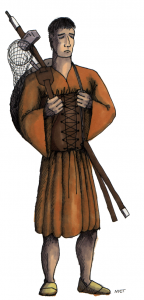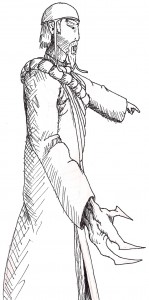 There are four types of special forces. Surgical Strike, Infiltration, Demolition and Counter Insurgency. The average day in a Chezbah Warrior’s life is counter insurgency so there is no specialist for that role.
There are four types of special forces. Surgical Strike, Infiltration, Demolition and Counter Insurgency. The average day in a Chezbah Warrior’s life is counter insurgency so there is no specialist for that role.
Two of the special forces roles are not carried out by Warriors but rather by conscripts these are Infiltration and Demolition. The Surgical Strike role is still the realm of Warriors.
Infiltration – Mask Wearers
The unit called the Mask Wearers are a group of conscripts that are trained to sneak into enemy ranks and gain information or possibly sow dissent. They have equipment that creates a lifelike disguise of either a Scimrahn or a Kelrath although there are rumors of a Earther disguise in use. Only very tall conscripts are chosen to disguise themselves as Kelrath.
Attributes
CON 25
STR 25
AGI 50
REF 50
DEX 60
BTY 30
CHA 60
INT 60
IQ 60
PSY 60
H.P. 7
Equipment
Nanotech Lifelike Masks
These masks are amazingly life like, they read the electrical signals and blood flow in the face to mimic facial expressions and blushing.
Masks cannot be removed unless the wearer wants to remove it. Microscopic hairs grip the skin stronger than most glues. The mechanism that allows the wearer to release this hold is under investigation. The hope is that a way can be found to release the masks remotely.
The masks are powered by chemical solution that is in the mask itself. It is not known how long the masks function but it is thought to be at least several weeks.
Masks stolen from the wearers are rare and so this item is not normally available.
Mass: 50 g
Cost: 10-40 million yen
Demolition – Restorers
This group of conscripts are charged with the task of removing technology made illegally according to Chezbah law. The Restorers do not often use explosives to destroy. Their main tools are electromagnetic pulse generators, magnetic mines and sonic shakers.
Attributes
CON 45
STR 25
AGI 50
REF 50
DEX 60
BTY 30
CHA 30
INT 40
IQ 60
PSY 60
H.P. 15
Equipment
EMP Coil
These compact plasma coils are designed to discharge all their energy in a single burst through an antenna. The coil is robust enough that there is a 25% of the plasma engine can be re-used.
Effect: Active shield generators take a critical hit. Most combat vehicles are hardened so Sensors and other electronic systems have a (30%) chance of being damaged by the pulse. Although QLC computers are undamaged by the pulse, secondary systems that interface with the computer may be damaged (20%).
Blast Range Class: B
Mass: 25.6 Kg
Used once cost: (25% chance that it will work a second time) 800,000 Yen
Magnetic Mine
These Magnetic mines are more compact than those produced by the Scimrahn.
Magnetic mines are used to reduce or eliminate the effectiveness of force fields in a local area. They work by inducing a powerful magnetic field that disrupts the ion flow in the force fields. Magnetic mines need to be well hidden (usually buried) to prevent them from being detected and destroyed.
| PB | S | Med | L | Ex | |
| Damage: | 1200 | 1000 | 700 | 400 | 200 |
Effective Radius Class: C
Duration: 5 minutes
Mass: 136.8 Kg
Cost: ¥9,000,000
Sonic Shaker
This device is planted on a building or vehicle. It looks for a resonant frequency and then sends sound waves through the structure slowly shaking it apart.
Effect: Only effects machines and structures. Ignores force fields and armor. Takes 3d10 minutes to find the resonant frequency.
Damage: 50 per turn
Duration: 3 hours
Mass: 8.2 Kg
Cost: ¥3,000,000
Surgical Strike – The Arm
These Warriors are equipped with long range lasers and Herf guns. The Arm is also given high speed vehicles to get in and out of their combat zones. They are also given advanced combat training.
Attributes
CON 80
STR 80
AGI 90
REF 80
DEX 65
BTY 20
CHA 40
INT 60
IQ 40
PSY 60
H.P. 35
B.P. 250
Equipment
Long Range Laser
| PB | S | Med | L | Ex | |
| Damage: | 40 | 40 | 25 | 20 | 15 |
Range Class: E
Payload: 30
Rate of Fire: 1
Mass: 16 Kg
Cost: ¥500,000
HERF Gun
HERF stands for High Energy Radio Frequency. The HERF gun concentrates it’s high energy radio wave in a tight beam. It can disrupt the function of many sensor and servailance equipment rendering them inoperable as long as the beam is focused on a device (Note: water, wet objects, foliage or forcefields in the path of the beam will block the beam).
Effective Range Class: D
Duration: 2 Hours
Mass: 4.6 Kg
Cost: ¥225,000




 The Free RPG Blog
The Free RPG Blog